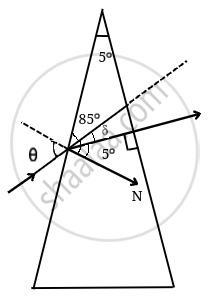Advertisements
Advertisements
प्रश्न
A ray of light incident at an angle θ on a refracting face of a prism emerges from the other face normally. If the angle of the prism is 5° and the prism is made of a material of refractive index 1.5, the angle of incidence is ______.
विकल्प
7.5°
5°
15°
2.5°
उत्तर
A ray of light incident at an angle θ on a refracting face of a prism emerges from the other face normally. If the angle of the prism is 5° and the prism is made of a material of refractive index 1.5, the angle of incidence is 7.5°.
Explanation:
In thin prisms, the distance between the refracting surfaces is ineligible and the angle of prism (A) is very small. Since A = r1 + r2, therefore if A is small then both r1 and r2 are also small, and the same is true for i1 and i2.

A = 5°
μ = 1.5
i2 = 0°
r2 = 0°
r1 + r2 = A
r1 = A - r2 = 5 – 0 = 5°
μ = `(sini1)/(sinrlμ) = (sinil)/(sinrl)`
⇒ `sini1 = μsinr1`
= `1.5 xx sin 5°`
= 1.5 xx 0.087`
= 0.1305
= 7.5°
APPEARS IN
संबंधित प्रश्न
State the relation between the critical angle and the absolute refractive index of a medium.
Draw diagram to illustrate the total internal reflection.
How does a ray of light bend when it travels from denser to rarer medium.
Write down the relationship between the critical angle and the refractive index of the medium.
If a ray of light passes from medium I to medium II without any change of direction, what can be said about the refractive indices of these media (angle I is not 0)?
How are critical angles related to the refractive index of the medium?
A ray of light is incident on a glass surface at an angle of 50° with the corresponding angle of refraction 30°. Find the value of the R.I. of glass.
Answer the following question.
Under what conditions are total internal reflection possible? Explain it with a suitable example.
The critical angle is defined as the angle of incidence at which the total internal reflection starts to occur.
